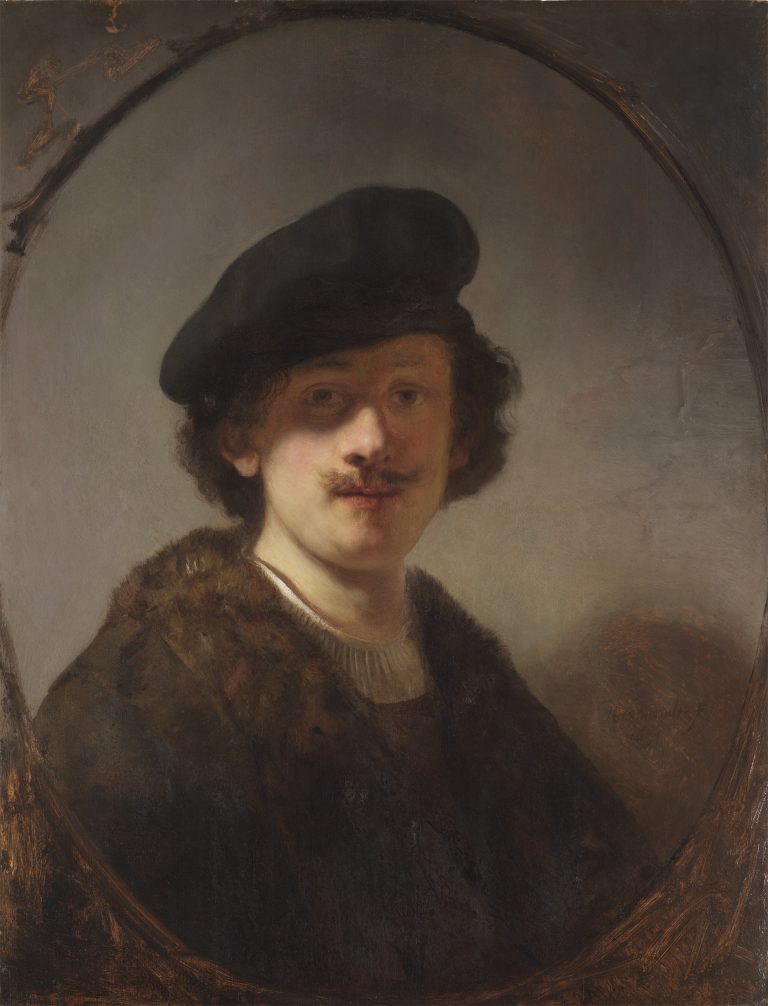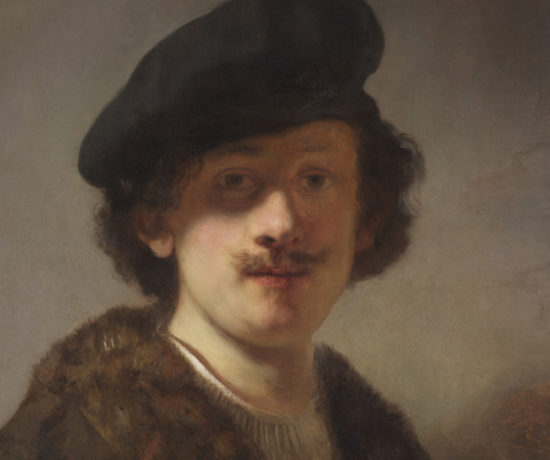This image of the young Rembrandt van Rijn, proud in bearing as he gazes directly out at the viewer from within an oval framing device, is not easily forgotten. With eyes gently shaded by his beret’s soft brim, Rembrandt’s gaze is compelling in its directness, yet one senses a restless mind that is only partially revealed. One cannot help but stare back, and thus become engaged in silent communication with the artist. It is a strange phenomenon, but suddenly, without recognizing the moment in which it occurs, the physical reality of the painted image blurs, and the psychological rapport between the viewer and Rembrandt begins.
Rembrandt’s expression reinforces the impression that he was not only a self-assured young man, uncompromising in his approach to the world, but also an enigmatic individual whose true personality he kept largely to himself. The painting seems so characteristic of Rembrandt’s work from the early 1630s that it is easy to overlook how striking its psychological ambiguity must have appeared to his contemporaries. Twenty-first-century viewers have come to judge Rembrandt’s character and artistic personality through the sum total of his life and work. Numerous paintings, drawings and etchings, as well as documents, stories and myths, have left an indelible impression of his extraordinary artistic achievements through a long, memorable career. Therefore, it is difficult to place oneself in Amsterdam in 1634, imagining how such an image would have been received by contemporaries familiar with a far more descriptive portrait tradition.
Rembrandt began exploring the expressive character of self-portraits in Leiden in the late 1620s, and he continued to depict himself in paintings, drawings and etchings throughout his career. Indeed, self-portraiture constitutes around one-tenth of his total surviving oeuvre.1 He incorporated a wide range of pictorial effects and devices in these works, far more so than he did in his commissioned portraits. The endless variety and invention of his self-portraits is such that no two look quite alike.
A number of Rembrandt’s early self-portraits relate to the tronies that he and Jan Lievens (1607–74) developed in Leiden, and they feature the kinds of emotional expressions, fancy costumes, loose paint handling, and striking light effects evident in those works. Echoes of Rembrandt’s early tronies are seen here in the artist’s expression, the strong lighting effects, and his imaginative costume, all of which differ from the formal presentation of his Self-Portrait of 1632 in Glasgow (fig 1).2 Whereas in that Self-Portrait Rembrandt closely followed the fashion among Amsterdam’s burghers by wearing a wide-brimmed hat and a flat ruff over a black coat, in the self-portrait in the Leiden Collection he has donned a beret, which by the 1620s was considered old-fashioned, although it continued to be favored by artists.3 The fur-trimmed robe he wears here also descends from sixteenth-century dress and relates to the tabbaard, a type of fur-lined cloak favored by scholars.4
This combination of beret and fur-trimmed robe may indicate that Rembrandt sought to portray himself within the framework of a scholarly and artistic tradition. Given that he painted Self-Portrait with Shaded Eyes in the year of his marriage to Saskia Uylenburgh, it is likely that he wanted to present himself as a sincere and legitimate artist-suitor, of a type different from artists who were characterized by such slurs as “hoe schilder hoe wilder” (the more of a painter the wilder he is).5 Rembrandt’s restrained modeling of his features in this painting also speaks to the thoughtfulness of his self-representation. As Ernst van de Wetering has emphasized, Rembrandt carefully modeled his flesh tones to capture the effects of reflected light in shaded areas, such as around the eyes.6
Remarkably, despite its compelling qualities, Rembrandt’s self-portrait was entirely overpainted by another hand soon after its completion, and it was only in the late twentieth century that the master’s original image was revealed once again. A photograph from the mid-1930s indicates that the overpainted image depicted an exotic middle-aged man with long, dark, curly hair, a moustache, and a thin beard (fig 2).7 He wore a fur coat and a tall Polish-style fur hat, a so-called kalpac trimmed with gold, similar to Rembrandt’s 1634 etched Self-Portrait with Raised Sabre (fig 3).8 He also wore a golden chain wound twice over his mantle, in a manner similar to that in Rembrandt’s Self-Portrait in the Wallace Collection, also from the 1630s.9
From the 1950s to the 1980s some of the overpainting was removed (fig 4), which revealed the existence of the beret under the kalpac. Technical research undertaken by the Rembrandt Research Project in the 1990s posited that the additions had likely been made in Rembrandt’s workshop around 1636/37, only a few years after the creation of the original painting. The remaining areas of overpaint were subsequently taken off with a scalpel by conservator Martin Bijl (fig 5).
Just why this repainting of Self-Portrait with Shaded Eyes was undertaken is not known, but it may have occurred if Rembrandt’s painting had not immediately found a buyer. In any event, it seems unlikely that the master would have authorized this repainting. A more probable scenario would be that the panel remained in the workshop of Hendrick Uylenburgh after Rembrandt’s departure in 1635, and that Uylenburgh decided to update the image. Uylenburgh may well have charged his new head painter Govaert Flinck with the task of turning this Rembrandt self-portrait into a tronie of an exotic figure.10 Flinck clearly knew Rembrandt’s self-portrait in its original format, for in 1636 he used it as a basis for an image of his former master as an amorous shepherd, as part of a pair with a shepherdess (fig 6).11 The loose handling of the repainting on Rembrandt’s Self-Portrait with Shaded Eyes corresponds to Flinck’s stylistic development around 1637. The fascinating transformation of this sensitive self-portrait into an exotic and somewhat frightening individual, and back again, serves as a powerful reminder of how works of art often have long and complicated lives that reflect differences of taste and values over the years.

